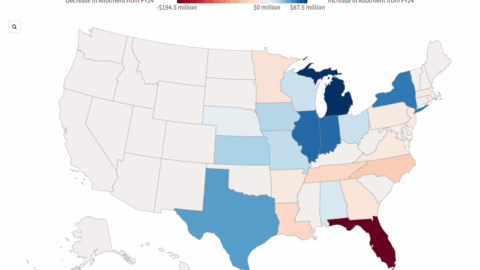A near-sisyphusian task: EPA soldiers on to require more testing under TSCA
Richard Denison, Ph.D., is a Senior Scientist.
The Environmental Protection Agency (EPA) announced yesterday that it has finalized a rule requiring testing [UPDATE 1/7/11: The published rule is available here] to determine basic health and environmental effects for 19 high production volume (HPV) chemicals. While I welcome this as well as any other effort to close the huge safety data gaps that exist even for the most widely used chemicals, the back story behind this rule reveals why it is actually a perfect poster child for what’s wrong with the Toxic Substances Control Act (TSCA).
For starters, consider that it took EPA two and a half years to move the rule from the proposed stage to finalization. And that doesn’t count the several preceding years EPA had to spend developing information sufficient to make the findings it has to make to justify proposing a test rule.
Then consider that the rule addresses only 19 of the many hundreds of HPV chemicals on the market today for which even the most basic, “screening level” hazard data are not publicly available.
And it gets worse.
Now don’t get me wrong. I applaud EPA’s doggedness in pursuing this effort to use its limited authority under TSCA to seek to elucidate the hazards of HPV chemicals – chemicals that are produced annually in volumes exceeding one million pounds. It’s a component of EPA’s enhanced chemicals management effort that I welcomed on this blog back in October 2009.
But while the efforts are not futile, they invoke that feeling of running faster and faster while falling farther and farther behind. That’s not EPA’s fault, it’s TSCA’s.
The 19 chemicals in question are all chemicals that were part of EPA’s voluntary HPV Challenge, under which companies agreed to “sponsor” their HPV chemicals, develop a base set of hazard data, and submit it to be EPA to be made public. That program fell short of its promises on a range of measures, but one was the fact that hundreds of eligible chemicals were never sponsored and became “orphans.” Meanwhile, many hundreds of additional chemicals not included in the original program have reached HPV levels – but without any effective commitment by their makers to develop the base set of hazard data.
When launching the HPV Challenge in 1998, EPA promised it would require companies to test any of their HPV chemicals they did not voluntarily sponsor. EPA has been trying to make good on that promise ever since, but the going has been exceedingly slow – because EPA must use its existing TSCA authorities.
The final rule announced yesterday is actually the second HPV chemical test rule EPA has finalized. The first one it proposed in 2000. It would have covered 37 HPV chemicals, but by the time it was finalized – more than five years later – that number had dwindled to 17 chemicals for which EPA could make the requisite findings needed to justify a test rule under its TSCA Section 4 authority. (EPA later withdrew the testing requirements for one of those 17.)
The second test rule (the one announced as final yesterday) was proposed in July of 2008. It covers 19 chemicals, but five of those overlap with the chemicals included in the first rule and are included to extend testing to additional endpoints based on further assessment of data gaps.
That means that it has taken EPA, using its existing TSCA authorities, more than a decade to be able to impose even minimal testing requirements on just 30 of the many hundreds of HPV chemicals on the market today for which even basic health and environmental data are not publicly available.
To be fair, EPA also proposed in February 2010 a third test rule covering 29 HPV chemicals. We can only hope it doesn’t take as long to finalize that one as it did the first two test rules.
Why does it take so long?
TSCA Section 4 test rules must be developed through full notice-and-comment rulemaking, hence also enduring two full rounds of OMB review, one before proposal and the other before finalization.
To justify such a test rule, EPA must first make one of the following statutory findings:
1. The substance “may present an unreasonable risk of injury to health or the environment” and the probability of exposure to it is more than just theoretical.
OR
2. The substance is produced in “substantial quantities” and either enters the environment in “substantial quantities” or there is “substantial or significant” human exposure.
In practice, EPA is rarely able to make the first, risk-based finding because it lacks the very data that testing would provide. In virtually all cases where it has issued test rules, EPA has relied on making the second, exposure-based finding, as it has in the present case.
Here are the criteria EPA uses to define “substantial” production and environmental release:
- substantial production/importation is one million or more pounds per year; and
- substantial release is one million or more pounds per year, or 10% of the total amount produced or imported.
EPA defines “substantial” human exposure as that affecting 1,000 workers, 10,000 consumers, or 100,000 members of the general population. Here again, however, EPA has to have sufficient information to document that these thresholds are met – information it is likely to have only if it has promulgated a wholly distinct TSCA Section 8(a) rule.
There are two other, non-trivial findings EPA must make in order to issue a test rule. EPA must show that:
- existing data are inadequate for risk assessment; and
- testing is needed to develop the data.
In practice, EPA often establishes the basis for making these findings through issuance of yet another rule, a “Health & Safety Data Reporting Rule” under TSCA Section 8(d). Such a rule requires producers of a substance to submit lists and/or copies of ongoing and completed, unpublished health and safety studies of the substance.
Making all of these findings in fact requires significant time, investigation and resources, as can be seen by perusing the nearly 100-page Federal Register notice EPA released yesterday.
In the present case of 19 chemicals, the road was actually much longer than the two and half years from proposal to finalization of the test rule. That process began with the development of Section 8(a) and Section 8(d) rules of the sort I just described, which were issued in the summer of 2006 (see the bottom of this page).
Sisyphus never had it so hard.
Clearly, this antiquated system is not anywhere near being up to the task of keeping up with a modern chemicals economy characterized by ever-expanding chemical production. New HPV chemicals – let alone chemicals produced in smaller volumes – are arising far faster than EPA could possibly promulgate test rules to provide the information needed to conduct even the most basic screening of their potential hazards.
What’s needed?
My answer to that question should come as no surprise: TSCA reform is needed – and that reform simply must give EPA the ability to get the information it needs to do its job. Here are a few musts:
- Upfront minimum data sets need to be required for all chemicals as a condition for entering or remaining on the market (see here and here for more on the why and what of minimum data requirements).
- EPA needs to have the authority to issue an order requiring submission of any additional data it needs to assess a chemical’s safety – rather than having to engage in the kind of protracted rulemaking it must currently use.
- EPA should not have to prove potential risk or widespread exposure before it can require data needed to determine the extent of hazard, exposure or risk. This Catch-22 must be eliminated.
Without authorities like these, EPA will continue to find itself between a rock and a hard place when it comes to getting good chemical information.













One Comment
I wanted to introduce you to Nanotechnology Dashboard and Resources on Academic Room: http://academicroom.com/discipline/411476 – Please provide us with you suggestions for improvement.